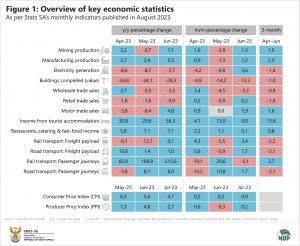Economic wrap-up for August 2023
Stats SA published 28 statistical releases in the month of August. Here is a monthly rundown of important economic indicators.
Consumer and producer inflation continue to cool
Inflation figures continue to provide some good news. Remaining on a downward path, consumer headline inflation slowed to its lowest reading in two years. The annual change in the consumer price index (CPI) was 4,7% in July 2023, the lowest print since July 2021 when the rate was 4,6%. The fall in fuel prices and slower inflation for food and non-alcoholic beverages contributed to the decline.
The headline change in the producer price index (PPI) also continued downward, tumbling from 4,8% in June 2023 to 2,7% in July 2023. This is the lowest reading since October 2020 when the annual change in the PPI was 2,7%.
The unemployment rate edges lower
Another bit of good news came from the latest Quarterly Labour Force Survey (QLFS) release, which showed the official unemployment rate declining slightly from 32,9% in the first quarter of the year to 32,6% in the second quarter. This is the lowest reading in the unemployment rate since the first quarter of 2021 (32,6%).
Despite the slight decrease, the country has a long way to go to reduce the official unemployment rate to levels last seen before the 2008–2009 global financial crisis. The lowest reading in the QLFS time series (which began in 2008) was 21,5% recorded in the fourth quarter of that year.
Quarterly figures for industry indicators
A number of Stats SA’s business cycle indicators were published in August (Figure 1), covering the month of June. These figures conclude the results for the second quarter (April–June) of the year.
South African mining production increased by 1,5% in the second quarter compared with the first quarter. Platinum group metals and gold were the key upward drivers of growth.
Manufacturing output was up by 2,3% in the second quarter, with nine of the ten manufacturing divisions reporting positive growth rates over this period. Petroleum, chemical, rubber & plastic products and metals & machinery drove much of the upward momentum.
South African retail trade sales was negative, decreasing by 1,0% in the second quarter. All retailer groups were weaker as consumers opted to hold back on spending, with the general dealers category (which includes supermarkets) the biggest drag on overall growth.
What to look forward to in September
The next set of gross domestic product (GDP) figures will be released on Tuesday, 5 September at 11:30. These figures will provide insight into how the economy performed in the second quarter of 2023. Make sure to visit this page to access the release and data.
After a two-and-a-half-year hiatus, Stats SA plans to resume the publishing of provincial-level GDP figures with the first release set for 26 September 2023. Keep an eye on our publication schedule and social media feeds for announcements.
For a comprehensive list of products and releases from Stats SA, download our catalogue. For a monthly overview of economic indicators and infographics, catch the latest edition of the Stats Biz newsletter here. Similar articles are available on the Stats SA website and can be accessed here.


